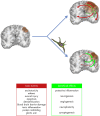Neuroprotection in Traumatic Brain Injury: Mesenchymal Stromal Cells can Potentially Overcome Some Limitations of Previous Clinical Trials
- PMID: 30405517
- PMCID: PMC6208094
- DOI: 10.3389/fneur.2018.00885
Neuroprotection in Traumatic Brain Injury: Mesenchymal Stromal Cells can Potentially Overcome Some Limitations of Previous Clinical Trials
Abstract
Traumatic brain injury (TBI) is a leading cause of death and disability worldwide. In the last 30 years several neuroprotective agents, attenuating the downstream molecular and cellular damaging events triggered by TBI, have been extensively studied. Even though many drugs have shown promising results in the pre-clinical stage, all have failed in large clinical trials. Mesenchymal stromal cells (MSCs) may offer a promising new therapeutic intervention, with preclinical data showing protection of the injured brain. We selected three of the critical aspects identified as possible causes of clinical failure: the window of opportunity for drug administration, the double-edged contribution of mechanisms to damage and recovery, and the oft-neglected role of reparative mechanisms. For each aspect, we briefly summarized the limitations of previous trials and the potential advantages of a newer approach using MSCs.
Keywords: brain protection; brain repair; mesenchymal stromal cells; traumatic brain injury; vulnerability.
Figures

Similar articles
-
MesenchymAl stromal cells for Traumatic bRain Injury (MATRIx): a study protocol for a multicenter, double-blind, randomised, placebo-controlled phase II trial.Intensive Care Med Exp. 2023 Aug 25;11(1):56. doi: 10.1186/s40635-023-00535-1. Intensive Care Med Exp. 2023. PMID: 37620640 Free PMC article.
-
Mesenchymal stromal cell secretome as a therapeutic strategy for traumatic brain injury.Biofactors. 2019 Nov;45(6):880-891. doi: 10.1002/biof.1563. Epub 2019 Sep 9. Biofactors. 2019. PMID: 31498511 Review.
-
Propranolol and Mesenchymal Stromal Cells Combine to Treat Traumatic Brain Injury.Stem Cells Transl Med. 2016 Jan;5(1):33-44. doi: 10.5966/sctm.2015-0065. Epub 2015 Nov 19. Stem Cells Transl Med. 2016. PMID: 26586775 Free PMC article.
-
Wnt3a, a Protein Secreted by Mesenchymal Stem Cells Is Neuroprotective and Promotes Neurocognitive Recovery Following Traumatic Brain Injury.Stem Cells. 2016 May;34(5):1263-72. doi: 10.1002/stem.2310. Stem Cells. 2016. PMID: 26840479
-
Neuroprotection for traumatic brain injury.Handb Clin Neurol. 2015;127:343-66. doi: 10.1016/B978-0-444-52892-6.00022-2. Handb Clin Neurol. 2015. PMID: 25702227 Free PMC article. Review.
Cited by
-
The potential roles of dopamine in traumatic brain injury: a preclinical and clinical update.Am J Transl Res. 2019 May 15;11(5):2616-2631. eCollection 2019. Am J Transl Res. 2019. PMID: 31217842 Free PMC article. Review.
-
The role of long noncoding RNA in traumatic brain injury.Neuropsychiatr Dis Treat. 2019 Jun 28;15:1671-1677. doi: 10.2147/NDT.S206624. eCollection 2019. Neuropsychiatr Dis Treat. 2019. PMID: 31303755 Free PMC article. Review.
-
Potential of mesenchymal stem cells alone, or in combination, to treat traumatic brain injury.CNS Neurosci Ther. 2020 Jun;26(6):616-627. doi: 10.1111/cns.13300. Epub 2020 Mar 10. CNS Neurosci Ther. 2020. PMID: 32157822 Free PMC article. Review.
-
3D printing of interferon γ-preconditioned NSC-derived exosomes/collagen/chitosan biological scaffolds for neurological recovery after TBI.Bioact Mater. 2024 May 28;39:375-391. doi: 10.1016/j.bioactmat.2024.05.026. eCollection 2024 Sep. Bioact Mater. 2024. PMID: 38846528 Free PMC article.
-
Novel Synthetic and Natural Therapies for Traumatic Brain Injury.Curr Neuropharmacol. 2021;19(10):1661-1687. doi: 10.2174/1570159X19666210225145957. Curr Neuropharmacol. 2021. PMID: 33632101 Free PMC article. Review.
References
-
- Edwards P, Arango M, Balica L, Cottingham R, El-Sayed H, Farrell B, et al. . Final results of MRC CRASH, a randomised placebo-controlled trial of intravenous corticosteroid in adults with head injury-outcomes at 6 months. Lancet Lond Engl. (2005) 365:1957–9. 10.1016/S0140-6736(05)66552-X - DOI - PubMed

